
Tuesday August 03, 2004
Fly Alfa Romeo 156 GTA
1st Place - FIA ETCC 2002
- Fabrizio Giovanardi
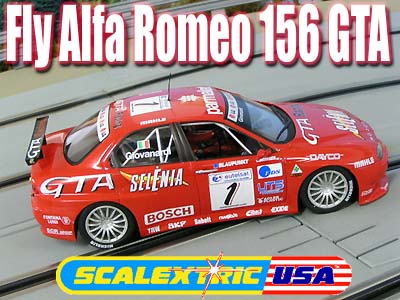 The
latest to arrive from Fly might not appeal to everyone, but those who appreciate
fine scale detail along with decent performance should take notice. This version
of the Alfa is quite a different machine on the track than the
previous Alfa 147 produced, and fans of this series
should certainly look forward to it.
The
latest to arrive from Fly might not appeal to everyone, but those who appreciate
fine scale detail along with decent performance should take notice. This version
of the Alfa is quite a different machine on the track than the
previous Alfa 147 produced, and fans of this series
should certainly look forward to it.
I must admit that I am not really a huge fan of this series, however most of this is due to simply not being exposed to it. I have managed to see some action from time to time and the racing that I have been fortunate enough to witness was very exciting to say the least. Fly has reproduced in 1/32nd scale, an excellent replica of the Alfa Romeo 156 that Fabrizio Giovanardi piloted to first place in the 2002 ETCC (European Touring Car Championship) and also helped Alfa win the manufactures championship that same year.
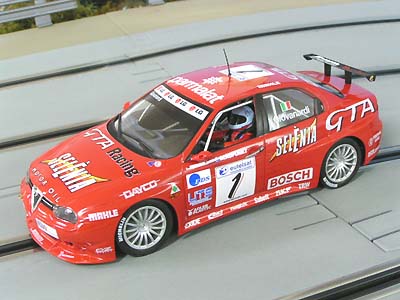
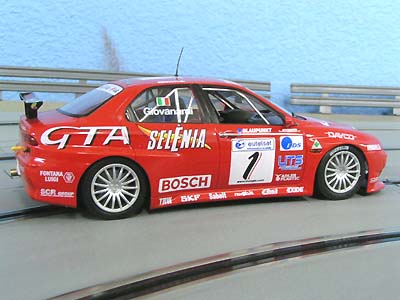
Just looking at this car should impress you. Tampo-stampings and artwork are simply fantastic to my eyes and Fly has even applied a good clear-coat over most of them. Marking placement is a very close match to prototype photos I happened across and the effort should please almost any fan. It is the color combination that makes this model so striking to me and the detail just draws you in closer.
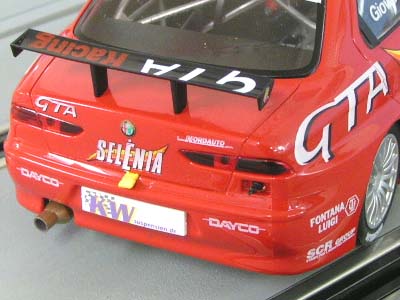
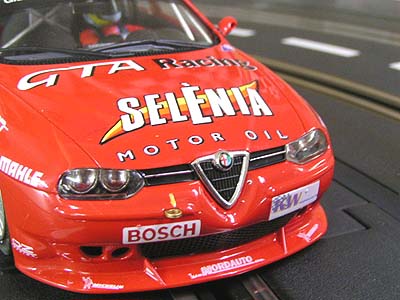
The interior is very well done, in fact it is loaded with detail. Some people don't care for extra detail, but this interior really draws you inside to look around. Intricate roll bar, chrome fire bottle and a nicely done dash assembly are all trademarks of Fly and it is in full force here. Whether we like it or not, there are a good many collectors and racers out there who want a model as close to the real thing as they can get, and this level of detail should please most of them.
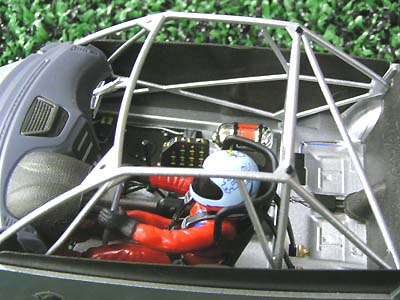
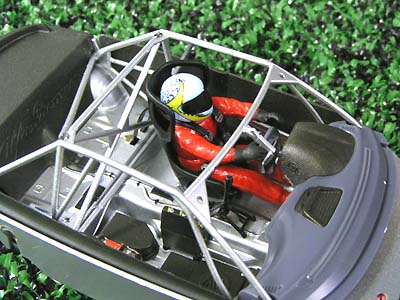
Underneath, the chassis itself has added detail such as exhaust and molded suspension which is highlighted in silver to expose it. I realize most racers could do without detail that you "can't" see, but there must be a reason why Fly continues to make them this way. I have simply come to accept it as it doesn't interfere with the operation of the model.
Wheels and tires are pretty much standard fare for Fly and will need some sanding to get them right. Separate plastic brake rotors are visible in the wheels and add a nice touch of detail. You might find however that these rotors can sometimes pop loose during heavy racing. If this happens, just remove the wheel and press the rotor back in place and add a light drop of your favorite adhesive to keep it there.
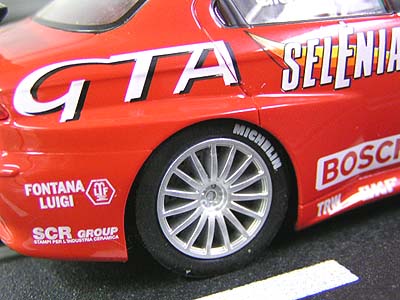
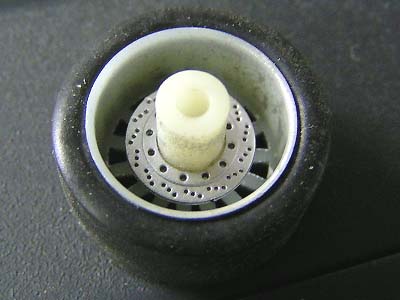
Underneath we see that 3 screws mount the body to the chassis and all were easily removed. We also notice that Fly has outfitted this model with a "competition" motor instead of the standard Mabuchi found in the earlier Alfa 147. To their credit, this motor, which is identical to those found in the new Vipers, can be easily replaced with a standard motor for smaller home tracks. The new racing motor has a plastic adaptor that is mounted on the end and when you remove the motor, it goes with it and you can see where the standard motor is a snap-in replacement.
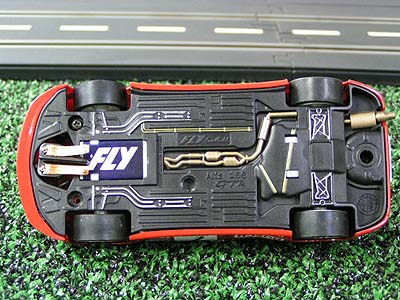
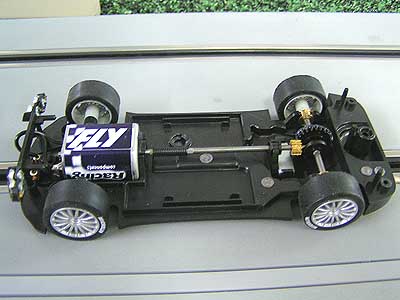
Our out box test shows that this motor has power and plenty of it. And although those with larger layouts will simply love the top speed of these, some of us prefer a milder set-up, especially when our layouts are not the size of a gymnasium. During the test, this model was VERY fast and braking and acceleration are very crisp. You can dive very deep into even the tightest of turns and have the punch of prize fighter coming out.
One thing that we did find during the initial test were that the front wheels were rubbing the top inside of the body in the turns. The culprit is the old standard post-style wheel mounts used on most all front motor configured models. Usually, all you need to do is press the wheels on a little more to eliminate the excess free-play these sometimes have, but this time these efforts didn't work. We removed the body and using a twisting motion and a little elbow grease, they will pop off. Then we simply used a flat file to shorten up the post axles and tried pressing them on tighter and it worked. Now the front wheels had less slop to them and we eliminated the rubbing effect. And this is all this model needed aside from some braid adjustment. I think it is time Fly looked closer at this design. It is possible to outfit these systems with better components and with all the work they do in the detail and scale department, it is high time they turn their efforts here.
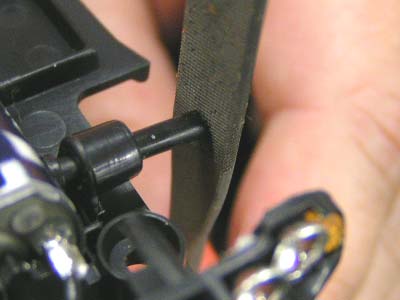
The driveline components were very solid and secure in their mounts and I didn't notice any movement under a heavy load. However, all my models get adhesive on the bushings and this car was no exception. One thing you might notice is that the magnet is slightly loose in the bracket and might cause excess noise. I added a drop of adhesive on each side of it to keep it pinned and to minimize vibration.
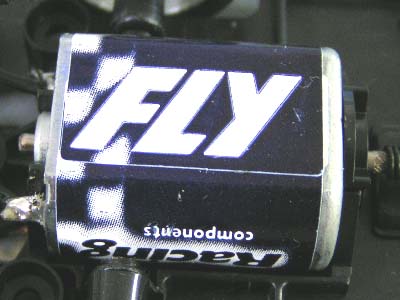
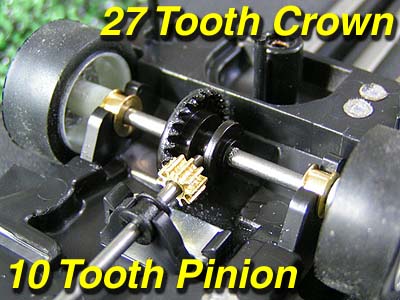
The 26,500 RPM racing motor is equipped with a 10 tooth pinion instead of the old standard 9, but still keeps the 27 crown gear (2.70:1 ratio compared to older 3.00:1). This pinion change was surprising to say the least given the fact the first Alfa and the BMW are both using the old standard. However, this change seems to be for the better. Given the lighter pitch, the system is much quieter out of the box and break-in will only makes things better. Secondly, as I stated above, this model can really brake and accelerate with all the power you could ask for on a home track with lap times being very brisk with the Alfa pulling in 4.2 averages.
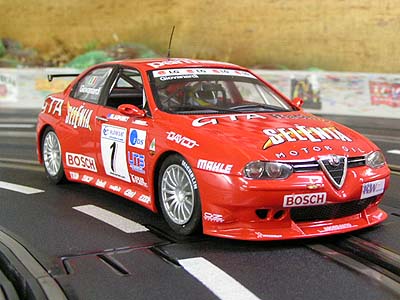 Overall
this model is a very good slot car with drop dead good looks. Of course, not
everyone will agree but once you try it on the track you might change your mind.
The gearing change combined with the racing motor should satisfy anyone craving
the need for speed and is easily adjusted to suit other driving tastes.
Overall
this model is a very good slot car with drop dead good looks. Of course, not
everyone will agree but once you try it on the track you might change your mind.
The gearing change combined with the racing motor should satisfy anyone craving
the need for speed and is easily adjusted to suit other driving tastes.
- Harry
As always feel free to contact me about this article or just the hobby in general at harry@homeracingworld.com, or better yet drop into our Message Forum and share your thoughts with other enthusiasts!
Thanks go to Scalextric-USA for providing us with this model.